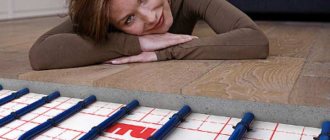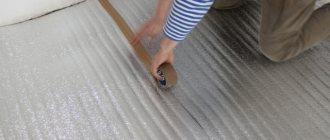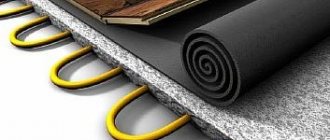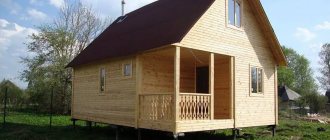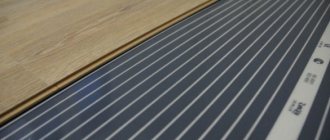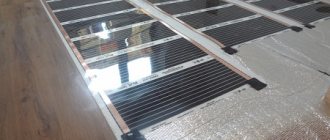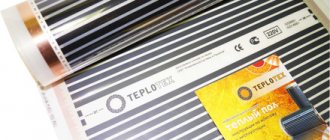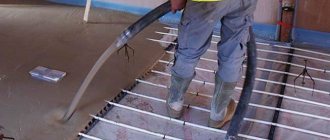Depending on the heating method, heated floors are divided into several types. Water surfaces are heated using a pipe system, with water playing the role of coolant. The underlay for a heated floor is important because the correct operation of the heating system as a whole depends on its condition.
When choosing a substrate, you need to approach the choice very responsibly:
Main characteristics of the material
Laying a foil backing under a heated floor can reduce heat loss.
A backing with foil is a multilayer material. The base of the insulation can be mineral wool, expanded polystyrene or foamed polyethylene or polypropylene. The base layer provides the heat and sound insulation properties of the material. Foil for heated floors serves as a reflector of infrared waves. The metallized surface reduces heat loss and prevents the penetration of water vapor.
Main characteristics of the foil substrate:
- reflectivity;
- moisture resistance;
- elasticity;
- durability;
- excellent vapor barrier properties;
- light weight;
- sound insulation.
The effectiveness of reflective insulation depends on the thickness of the aluminum layer. Sputtering of 12-15 microns transmits radiation without performing its function. High-quality foil should be applied in a layer of 30-50 microns.
Another significant criterion is the thickness of the insulation. There are materials from 2 to 10 mm. The floor level in the room will rise to this height. To save space, choose a substrate no larger than 5 mm.
What type of thermal insulation is better to choose and why?
When choosing foil material for heated floors, you need to consider:
- heat reflecting properties;
- thermal conductivity coefficient;
- resistance to high temperatures;
- presence of sound insulation;
- environmental safety;
- reaction to moisture;
- prostate in styling;
- fire safety indicators.
Video - ways to reflect thermal energy, how insulation works
Attention!!//The truth about foil insulation//where does such insulation work?//Ivan Serba 2022.
The price of insulation for heated floors also plays an important role. For example, polyethylene foam coated with aluminum, or polystyrene foam substrate with a reflective layer, are affordable in cost.
But when buying multifoil or foilisolone, you will need to spend a decent amount. Mineral or basalt type insulation, although inexpensive, is not suitable for warm floors.
In addition, the thickness of the foil layer also plays a big role. In cases where conventional spraying is used on top of the heat-insulating fabric as a reflective layer, the efficiency of the product is significantly reduced. The lower the quality of the reflective surface, the easier it is for heat to pass through it.
For your information! Products that are intended for insulation of walls or ceilings should not be used for heating floors. After all, there they will be subject to mechanical stress, which can lead to the loss of their properties. Therefore, you only need to install insulation intended for the floor.
Also, when choosing a thermal insulation material, it is important to consider that:
- More often, the product in tiles is used for heated floors;
- foil mats are used to make floating screeds; they are laid between the joists.
The need to use a foil backing
Concrete screed takes a long time to heat up and cools down quickly.
Foil retains heat in the room Experts in laying underfloor heating systems unanimously confirm the need to lay a substrate. The thermal insulation layer prevents energy loss through the concrete screed layer. The low thermal conductivity coefficient is ensured by the structure of the material. Closed cells of synthetic fabrics filled with air and randomly laid mineral wool fibers are reliable heat insulators.
Foil under heated floors is used as reflective insulation. The metallized layer promotes uniform heating of the room. A significant coating area that directs infrared radiation into the room allows you to save up to 97% of energy. Using a substrate reduces the time it takes to warm up the room and reduces heating costs. The function of the material is also to protect the heating elements from moisture entering through the base.
When choosing a substrate, take into account the type of heated floor and the finishing floor covering. For a water floor system, choose rigid insulation that can withstand high loads. The aggressiveness of the concrete screed with which the pipes are poured should be taken into account. The substrate must have a protective coating. The option with a resistive or self-regulating heating cable can be laid under an adhesive solution that does not harm the aluminum film. For such a system, foil underfloor heating is the best choice.
One of the types of electric heated floors are heating mats. These are wires laid according to a diagram and secured to a fiberglass base. A substrate with an aluminum reflective surface is also effective for them. Infrared film mats placed under laminate, parquet or carpet can overheat the foil, causing a short circuit. For IR film, a metallized Mylar coated substrate is recommended.
Practical recommendations for choosing a substrate for various floor coverings
Professional builders recommend selecting a specific type of underlay, taking into account many existing factors, one of them is the type of finishing flooring. Let's look at a few of the most common options.
- The final coating is ceramic tiles. The tiles should be laid on a cement-sand screed; this creates significant additional loads on the substrate. It is recommended to choose materials with high load-bearing capacity: extruded polystyrene foam or OSB boards. In polystyrene foam, the pipes of the heating system can be hidden in special grooves - the overall height of the heating cake is reduced. Ceramic tiles conduct heat well, are not afraid of heating to high temperatures, and by all indicators are considered the best option for water-heated floors.
- The final coating is laminate. It is light in weight and can be used under any type of substrate, including the softest ones. The main requirement is maximum heat saving rates. The fact is that laminate itself does not conduct heat well; if heat saving is ineffective, then energy losses increase significantly, and water floor heating becomes unprofitable.
- The finishing coating is linoleum. Very soft material, laid on special plasterboard boards with additives to increase strength. There are options for mounting on sheet plywood or OSB, but these materials do not transmit heat well from the system, which reduces its efficiency. Gypsum is heavy, the substrate must have increased physical strength. Cork, foam or polystyrene foam are recommended.
Options for using natural boards or parquet as a finishing coating for heated floors should not be considered. It is not recommended to use such schemes for arranging water heating; there is no return, and many problems arise. During prolonged use at elevated temperatures, natural wood will certainly dry out and cracks will appear on it. In critical situations, they will need to be completely replaced with dismantling of the heating system. In addition, natural wood is considered an excellent heat insulator; accordingly, the heating system will work on its own, with minimal impact on the microclimate.
The substrates may have standard grooves for laying heating system pipes or protrusions (bosses). The second option is considered universal; it does not limit the type of system outline; during installation, you can choose any position, taking into account the geometric features of the room. Individual slabs are assembled into a durable structure using a tongue/groove system and may have additional fastening locks. To facilitate installation, some manufacturers provide approximate layout diagrams of heating pipes on the outside of the substrates.
Which substrate is better to choose?
Review of characteristics of different types of substrates
Features of underlays for heated floors
Foil-coated stone wool is a strong, durable material.
Technical characteristics of the substrate depend on the type of base layer:
- Mineral wool. Insulation is sold in the form of rigid slabs or mats. Its advantages: fire safety and low thermal conductivity. Thickness from 20 to 100 mm. A significant disadvantage of mineral wool is the phenolic compounds used to bind the fibers. When heated, harmful substances are released. The substrate is not suitable for a water floor; with a small leak, it loses its insulating properties. Popular brands with a minimum content of organic binders: Rockwool, Paroc, Izover.
- Extruded polystyrene foam with a layer of foil. The substrate is produced in the form of mats of small thickness (about 20 mm). It has chemical and biological resistance and serves as additional waterproofing. The material is designed for temperatures from -180 to +180°C.
- Foamed polyethylene insulation is characterized by minimal heat and vapor permeability. To improve its properties, it is laminated with foil. Elastic elastic material smoothes out unevenness of the base well. It is environmentally friendly and designed for long-term use.
Substrates differ significantly in price. The most affordable are mineral wool and polyethylene foam. Expensive options include multifoil and foilsolone.
DIY foil laying technology
Foamed polyethylene is the most common material for the substrate.
Working with roll reflective insulation is available to the home craftsman. Installation of the material does not require special tools or knowledge. Required:
- roulette;
- scissors;
- aluminum tape.
The process of laying the lining begins after leveling and waterproofing the base. Cracks and recesses in the concrete screed are covered with mortar. Bituminous mastic or liquid glass is used as a moisture insulator. To fix the substrate you will need special glue.
Install on a wooden floor immediately after cleaning the coating. The best option is to purchase material with a self-adhesive base. If there is no sticky layer, then use double-sided tape. The material is cut according to the area of the room. The individual parts are joined without overlap and placed close to the walls. The canvases are laid with a heat-reflecting coating facing up. The seams between the strips are closed with metallized tape. The procedure ensures the tightness of the overall coating. The underfloor heating system is installed on the substrate. After checking it, the finishing floor covering is laid.
Nuances of work
All of the above features of screed installation are basic. However, there are additional subtleties that should also be remembered before starting finishing work and operation.
First of all, you need to check the condition of the pipes immediately before pouring. Very often, immediately after putting the floor into operation, pipes begin to leak, become covered with corrosion or rust. Reliable prevention of heat loss is ensured by laying a heat-reflecting layer.
First of all, you need to check the condition of the pipes immediately before pouring
You should carefully select the materials used when installing heated floors. The main material of this type is cement. Most brands of this product begin to cake after a certain period of time and lose their quality characteristics. Professionals recommend purchasing cement on the eve of its use so that it does not remain inactive for too long and does not lose its properties.
Further care of the finished screed does not cause any difficulties. The main thing is to ensure normal humidity for a week after pouring. This is necessary because the cement becomes strongest 25 days after the mortar is prepared.
To maintain various chemical processes that have a beneficial effect on the condition of the coating, you need to use ordinary water. The material should completely harden, but not dry completely. Due to the natural drying of the screed, the material will not have time to harden at all, its performance properties will not meet the requirements. Thus, the screed can dry only after it has reached the required strength. Otherwise, the frozen mortar may crack.
Connection diagram for a warm water floor
Popular brands of foil substrates
Materials based on foamed polymers are in greatest demand among buyers.
Folgisolone
Folgisolon can withstand temperatures up to 100 degrees
. The IZOLON brand offers thermal insulation made of polyethylene foam. The material has a closed cellular structure. By applying a layer of foil or metallized film, the insulation reflects up to 97% of infrared waves. Two types of material are available:
- Cross-linked polyethylene foam - the canvas has excellent thermal insulation characteristics and a long service life.
- Non-crosslinked polyethylene foam - the product is inferior in strength to its analogue, but costs less.
The thermal conductivity of foil insulation is 0.036 W/(m*K), operating temperature is up to 100°C, water absorption is less than 1%. Insulating the floor with foilsolone provides a high-quality substrate that is not afraid of moisture and dynamic loads. The products are produced in rolls 1 m wide, 25 and 50 m long. Installation of vapor and sound insulation is not required.
Ecofol
The soft and elastic insulation is made of foamed polyethylene, backed with a layer of metallized film. There are two types of product:
- Ecofol A – heat insulator with a layer of metallized lavsan film;
- Ecofol S – the canvas is covered with foil on one side and a self-adhesive layer on the other.
The material is suitable for all underfloor heating systems. In terms of insulating characteristics, it replaces 15 cm of brickwork or 45 mm of wood. Ecofol is resistant to moisture and aggressive environments. The thickness of the rolled web is from 2 to 10 mm. One of the advantages of the product is that it comes with ready-made markings for laying heating elements.
Penofol
An inexpensive and reliable floor insulator consists of several layers. Its base is closed-cell polyethylene foam. The reflective properties of the material are given by the foil coating. The metallized layer is located on one or both sides. The aluminum coating has a thickness of 13-30 microns, and the canvas is 2-40 mm. Due to its low vapor permeability, Penofol prevents moisture from penetrating under the substrate. The material is environmentally friendly, does not rot, and weakly supports combustion. Low weight simplifies transportation and installation.
Multifoil
Multifoil is a multi-layer material with soundproofing properties.
Uponor produces a multi-layer product with reflective properties. It serves not only for thermal insulation, but also has sound and waterproofing characteristics. The base layer of multifoil for underfloor heating is polyethylene with closed air-filled cells filled with air. The surface of the insulation is covered with foil of a smooth or embossed structure. Roll width 100 cm, length 60 m, thickness 4 mm. Markings are applied to the metallized layer in increments of 50×50 mm.
Penoterm
The products of the Russian brand are suitable as a substrate for electric and water heated floors. It consists of foamed polymer and metallized Mylar film. The material serves as insulation and sound insulator. Penotrem is easy to cut and install. Its surface reflects 80% of infrared radiation. Thermal conductivity of the material is 0.034, operating temperature is from -40 to 150°C.
The substrate with the foil layer is an important part of the underfloor heating system. Its use increases overall heating efficiency and reduces energy losses.
Mermen
The heating system is a hot water pipeline. This type of heating is most popular in private houses, because in apartments management companies do not want to give permission to connect to central house networks.
There are at least two reasons for this. The first is that it is almost impossible to control the consumption of thermal energy for a specific person. The second is an increase in the load on heating boilers, which is why they simply cannot cope with their task.
Installing an individual boiler in an apartment is possible, but it is very expensive, and sometimes it is very difficult to obtain permission for this.

